Key takeaways:
- Connection pooling enhances application performance by reusing established database connections, significantly reducing wait times and system load.
- Key benefits of connection pooling include improved efficiency, resource optimization, and smoother scalability in high-traffic scenarios.
- Proper configuration and monitoring of connection pooling settings are crucial to prevent issues such as connection leaks and mismanagement of resources.

Understanding Connection Pooling
Connection pooling is a method used to manage database connections efficiently. Imagine you’re at a busy restaurant where the kitchen can only accommodate a certain number of chefs at one time; connection pooling works similarly by keeping a set number of connections open and reusing them as requests come in. This not only reduces the time spent on establishing connections but also minimizes the overhead of creating a new connection every single time a request is made.
I remember when I first started working with a web application that had long loading times during peak hours. It turned out they weren’t utilizing connection pooling, and the database was getting overwhelmed. After implementing connection pooling, the app’s responsiveness improved dramatically. It was like turning the chaotic restaurant into a well-oiled machine — suddenly, everything flowed smoothly, and the users felt the difference.
Have you ever wondered how large applications handle thousands of requests simultaneously without breaking a sweat? The answer often lies in connection pooling. By maintaining a pool of connections instead of creating one for each request, systems can efficiently channel user demands, striking the perfect balance between resource use and performance. That’s a game-changer in today’s fast-paced digital landscape where time is precious.
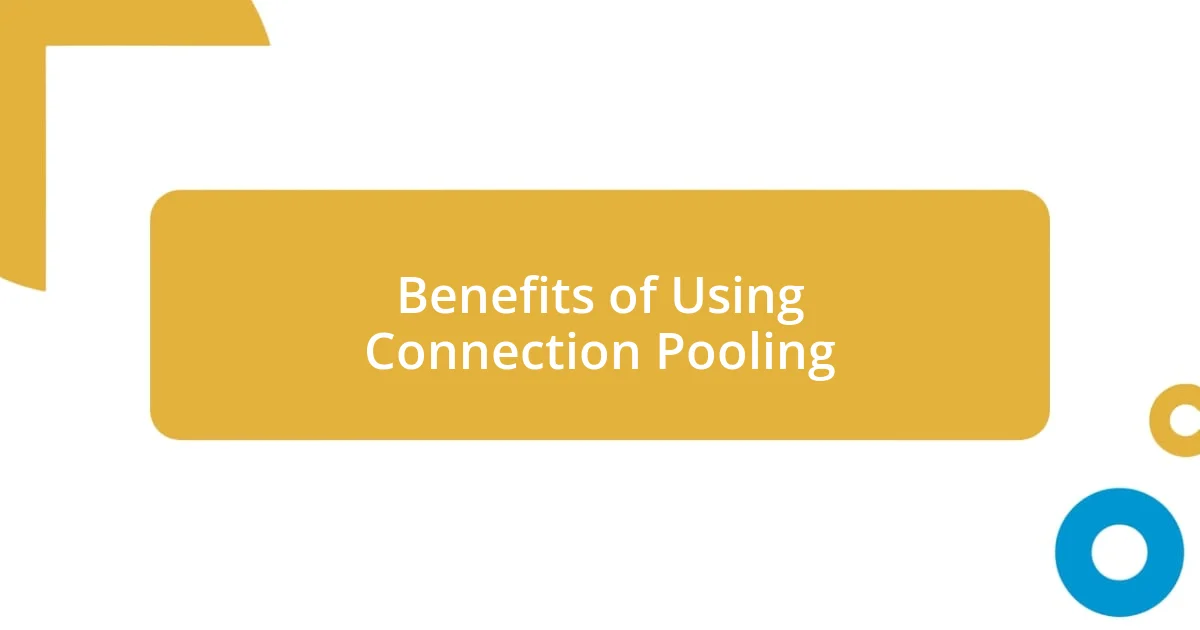
Benefits of Using Connection Pooling
Connection pooling offers remarkable efficiency, especially in high-traffic scenarios. I recall working on a project where we experienced drastic slowdowns during peak access times. By integrating connection pooling, we saw a significant reduction in wait times for users. It was incredibly satisfying to witness how a simple shift in our approach could enhance user satisfaction and streamline our application’s performance.
Another benefit is resource optimization. With connection pooling, the system conserves valuable server resources. I noticed that less CPU and memory were consumed after implementing this strategy. It’s fascinating how reducing the time spent on establishing new connections can free up resources that can be redirected towards more critical operations — it’s like realizing you could save money by simply changing your shopping habits.
Lastly, connection pooling enhances scalability. As an application grows, maintaining performance becomes challenging. I remember the thrill of watching our app handle triple the number of daily users after we leveraged connection pooling. The ability to efficiently manage concurrent connections means that scaling up can be smoother and less disruptive, making our systems ready to meet growing demands with confidence.
| Benefit | Description |
|---|---|
| Efficiency | Reduces time spent establishing connections, improving response times. |
| Resource Optimization | Conserves server resources by reusing existing connections. |
| Scalability | Facilitates smooth application scaling under higher user loads. |
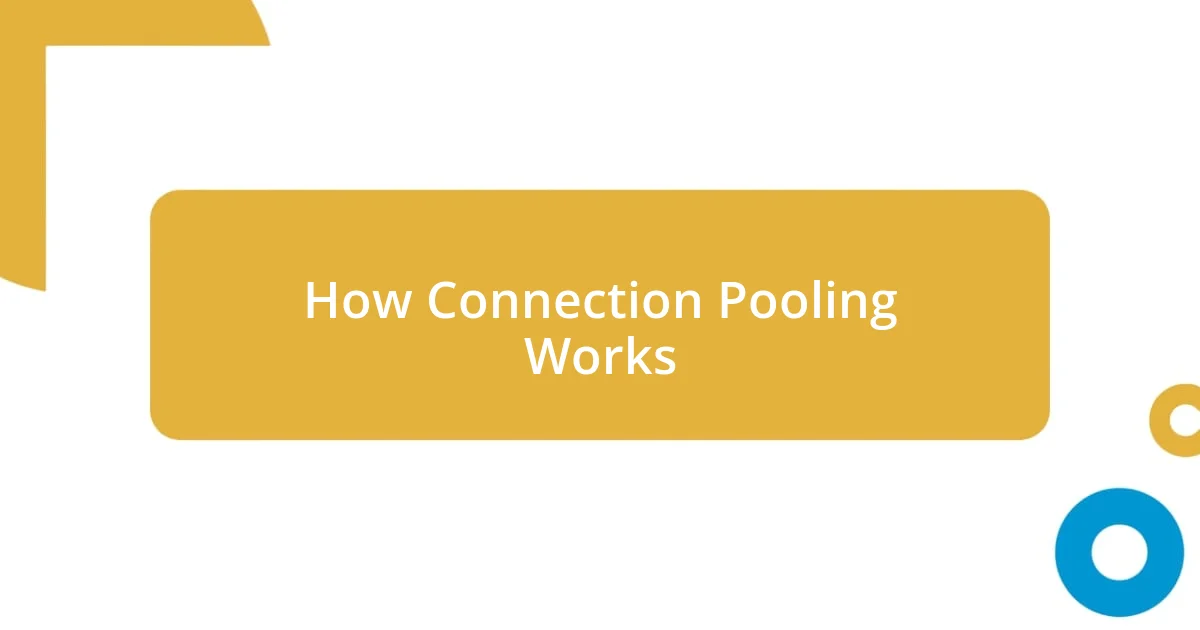
How Connection Pooling Works
Connection pooling operates by maintaining a collection of established database connections, ready to be utilized when needed. Picture a bus service: instead of every passenger requesting a new taxi, they hop on a bus that can carry multiple people at once. Each time a request for a connection arises, the system quickly hands off an existing connection from the pool rather than wasting time building a new one. This resource-efficient approach not only speeds up response times but significantly reduces the load on the database server.
- Connections are created once and reused, saving time.
- When a connection is no longer needed, it’s returned to the pool for future requests.
- The pool can have a maximum number of connections, preventing overloading of resources.
I vividly recall the first time I witnessed the magic of connection pooling in action. During a significant software launch, I was on edge, anticipating the flood of users. It felt like I was standing guard over a dam, ready to brace for impact. As the users poured in, my heart raced until I noticed that the application was seamlessly managing the load. The pool of connections acted like a seasoned traffic cop, directing user requests without a hitch. That moment transformed my understanding of application performance—connection pooling wasn’t just a technical strategy; it became a lifesaver, fostering both confidence and excitement in our team.
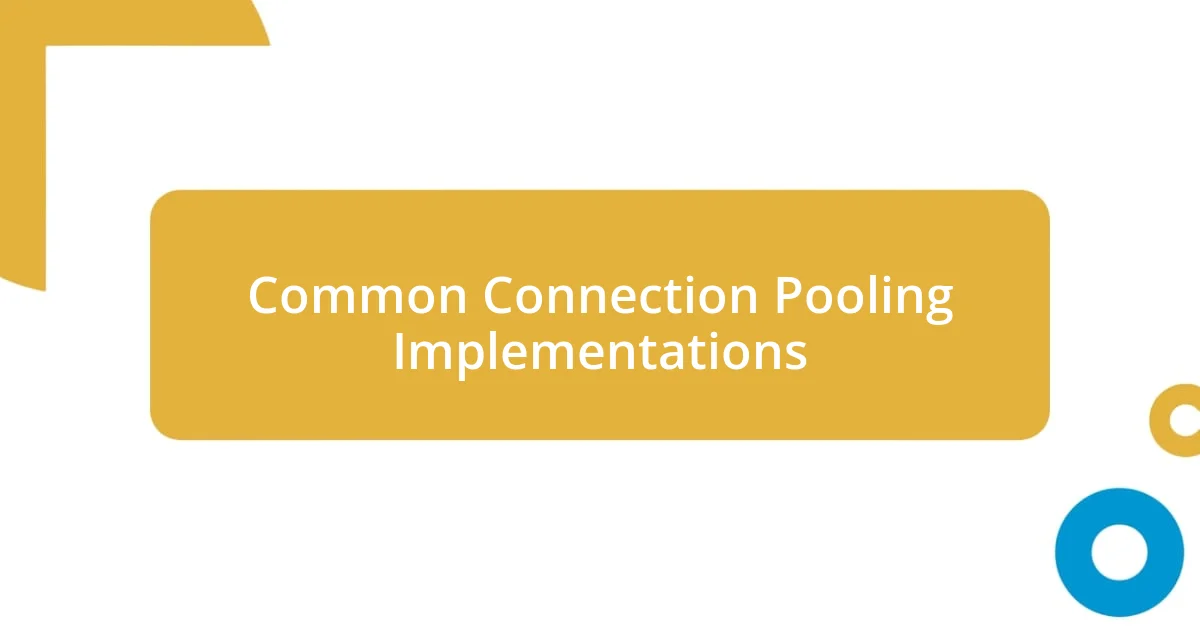
Common Connection Pooling Implementations
When it comes to common connection pooling implementations, I’ve seen several that stand out in the industry. For instance, many developers swear by HikariCP because of its impressive performance and minimal overhead. During a past project, we made the switch to this implementation and were amazed by how it reduced connection acquisition times—almost like trading a rusty old bike for a sleek sports car. Have you ever experienced that “wow” moment when a tool just clicks into place? That’s how HikariCP felt for our team.
Another popular choice is DBCP (Database Connection Pooling), which is known for its ease of use and configuration. I recall a particularly exhausting project deadline where every minute counted. Setting up DBCP felt like a relief; it enabled us to get a robust connection pooling solution up and running without diving deep into complex configuration files. It’s a bit like finding that perfect recipe that requires minimal ingredients but delivers delightful results!
Lastly, there’s C3P0, which also has its dedicated following. I remember a project where we faced intermittent connection issues with other pools. Transitioning to C3P0 not only made our connection management more reliable but also introduced useful features like automatic recovery of broken connections. It’s an incredible peace of mind, knowing that your application is resilient enough to handle unexpected hiccups—wouldn’t you agree that reliability in connection pooling can be a game-changer?
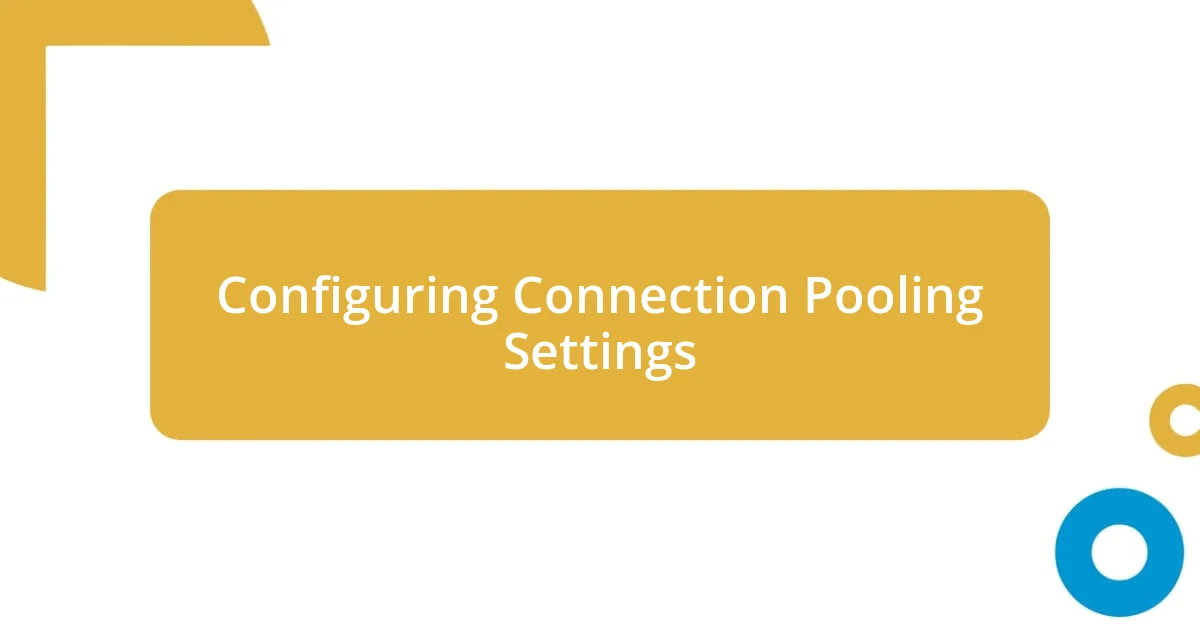
Configuring Connection Pooling Settings
Configuring connection pooling settings can significantly influence your application’s performance. When I first adjusted the maximum number of connections in our pool, it felt like I was conducting an orchestra; it required finesse to balance the right number of connections so that we weren’t under or overutilizing resources. Striking that balance can lead to smoother application flows, much like ensuring each instrument plays in harmony.
One important aspect I’ve learned is setting appropriate timeout values. By default, connection pools often come with rather conservative timeout settings. In one project, I experimented with these values after noticing occasional lag during peak usage times. Adjusting the connection timeout helped reduce waiting times for users, akin to letting everyone at a busy restaurant know that their table is ready just as soon as it’s cleared.
Additionally, monitoring and fine-tuning your connection pool is vital for long-term health. I’ve found that enabling logging for connection lifecycle events can provide insights into patterns and potential issues. It reminds me of keeping a close eye on a garden; one can’t just plant and walk away—regular tending reveals what’s flourishing and what needs more attention. How often do you evaluate your connection pooling settings? Discovering the right tweaks can be transformative.
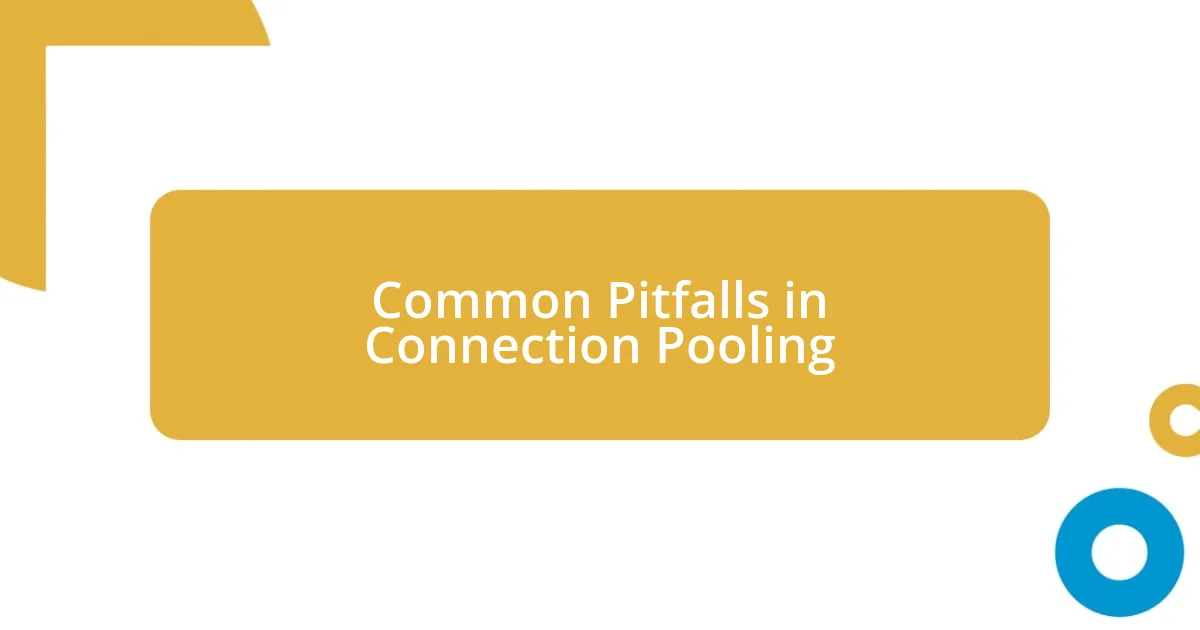
Common Pitfalls in Connection Pooling
One common pitfall I’ve noticed in connection pooling is the tendency to ignore connection leaks. I remember a time when I was working on a high-traffic application that started experiencing slowdowns. After some digging, we realized that we weren’t properly closing connections, leading to a gradual depletion of available connections. It felt like watching a bucket with a hole in it—no matter how much water we poured in, it just kept draining away. Have you ever had to troubleshoot a similar issue? Identifying and fixing these leaks can make all the difference in maintaining application performance.
Another challenge involves misconfiguring connection pool parameters. In one project, I assumed the default settings would suffice. However, I soon realized that we were overwhelmed with requests, and the pool couldn’t keep up. It reminded me of a crowded coffee shop where customers surged in, but only one barista was on duty—it just wouldn’t work! Adjusting those parameters was essential, and looking back, I can’t help but wonder how much smoother that project could have been with a little foresight.
Lastly, underestimating the importance of monitoring your connection pool can lead to bigger problems. During a particularly stressful sprint, we neglected to keep tabs on our connection usage. I distinctly recall the moment the application slowed to a crawl, and panic set in across the team. It was a wake-up call for me; just like how regular check-ups are crucial for health, monitoring connection metrics is vital for keeping your application robust. How proactive are you with monitoring your application’s performance? Trust me, preventing small issues before they escalate into headaches can save you time and stress.
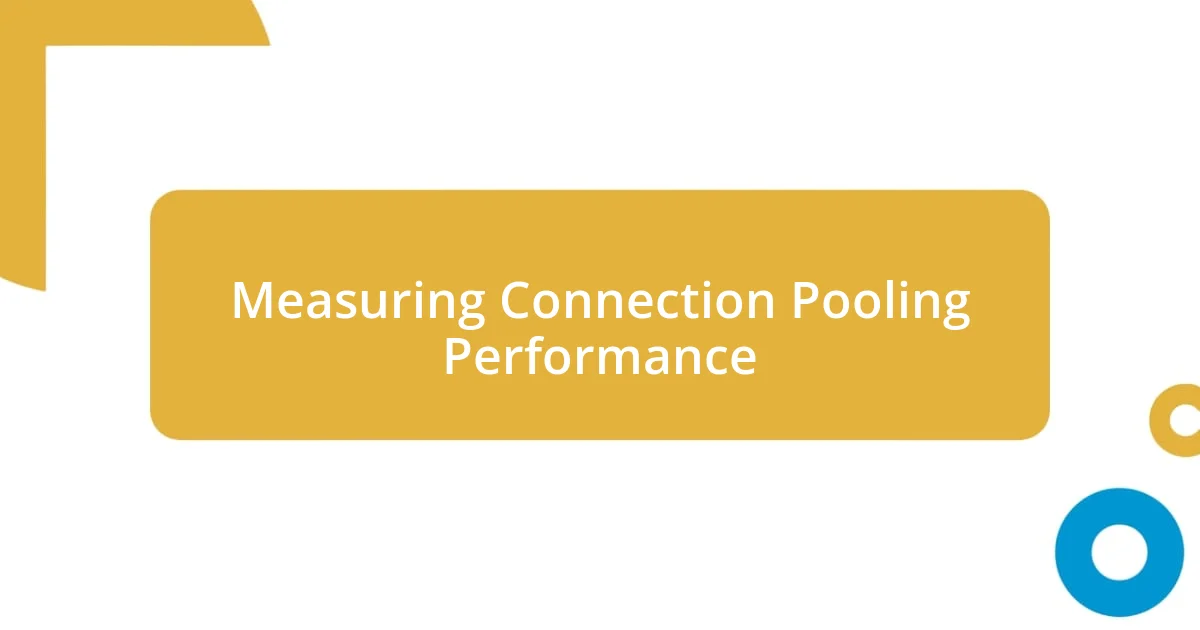
Measuring Connection Pooling Performance
Measuring connection pooling performance isn’t just a technical task; it’s an exploration of your application’s heartbeat. The first time I measured the throughput of my connection pool was an eye-opener. I used performance metrics to check the number of requests processed over time and, honestly, it felt like watching a race unfold right in front of me. Did all those configurations I painstakingly adjusted truly make a difference? In that moment, seeing the numbers, I realized how crucial it is to track not just the averages but also the peaks.
I’ve also discovered the value of benchmarking response times during different load scenarios. In a particularly demanding project, I simulated user traffic to gauge how my connection pool responded under strain. Witnessing the gradual degradation of response times as the number of requests surged was like watching a carefully balanced tower wobble. It raised an immediate question for me: How resilient is your setup when faced with unexpected spikes? This testing pushed me to rethink my strategies for scaling dynamically, ensuring the pool would adapt instead of falter when it mattered most.
Additionally, I find that visualizing these performance metrics can unveil insights that raw numbers might miss. I remember creating a dashboard that displayed real-time connection usage alongside current application performance metrics. The colors and graphs spoke to me—red flags where connections were saturated and green lights where efficiency thrived. Have you ever had such a moment of clarity that it spurred actionable changes? This visual feedback loop has become an indispensable part of my toolkit, helping me make informed adjustments rather than relying on intuition alone. It’s a powerful reminder that data-driven decisions pave the way for a smoother user experience.














